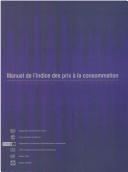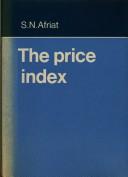| Listing 1 - 10 of 176 | << page >> |
Sort by
|

ISBN: 1462331084 1451994621 1589063309 Year: 2006 Publisher: Washington, D.C, : International Monetary Fund,
Abstract | Keywords | Export | Availability | Bookmark
 Loading...
Loading...Choose an application
- Reference Manager
- EndNote
- RefWorks (Direct export to RefWorks)
The consumer price index (CPI) measures the rates at which the prices of consumer goods and services are changing over time. It is a key statistic for purposes of economic and social policymaking, especially monetary policy and social policy, and has substantial and wide-ranging implications for governments, businesses, and workers, as well as households. This important and comprehensive manual provides guidelines for statistical offices and other agencies responsible for constructing CPIs and explains in depth the methods that are used to calculate a CPI. It also examines the underlying economic and statistical concepts and priniciples needed for making choices in efficient and cost-effective ways and for appreciating the full implications of those choices. The following international organizations, concerned both with the measurement of inflation and with policies designed to control it, have collaborated on the preparation of this manual: the International Labour Office; the International Monetary Fund; the Organization for Econmomic Co-operation and Development; the Statistical Office of the European Communities (Eurostat); the United Nations Economic Commission for Europe; and the World Bank.
Consumer price indexes --- Price indexes --- Price indices --- Index numbers (Economics) --- Methodology.
Book
ISBN: 4431559426 443155940X Year: 2020 Publisher: Tokyo : Springer Japan : Imprint: Springer,
Abstract | Keywords | Export | Availability | Bookmark
 Loading...
Loading...Choose an application
- Reference Manager
- EndNote
- RefWorks (Direct export to RefWorks)
This book answers the question of how exactly property price indexes should be constructed. The formation and collapse of property bubbles has had a profound impact on the economic administration of many nations. The property price bubble that began around the mid-1980s in Japan has been called the 20th century's biggest bubble. In its aftermath, the country faced a period of long-term economic stagnation dubbed the "lost decade." Sweden and the United States have also faced collapses of property bubbles in the 20th and early 21st centuries, respectively. It has been pointed out that the "information gap" that existed between policy-making authorities and the property (including housing) and financial markets was a problem. In 2009, the IMF proposed the creation of a housing price index to the G20 in order to fill this information gap, and the proposal was adopted. Furthermore, in 2011, it was suggested that the next economic crisis would be caused by a bubble in commercial property prices, and it was decided to create a commercial property index as well. This book provides practical examples of how the theory of property price indexes can be applied to the issues of property as a non-homogenous good and a technological and environmental change. W. Erwin Diewert is a Professor in the Vancouver School of Economics at the University of British Columbia. Kiyohiko G. Nishimura is a Professor at the National Graduate Institute for Policy Studies (GRIPS) and Professor Emeritus and Distinguished Project Research Fellow of the Center for Advanced Research in Finance at the University of Tokyo. Chihiro Shimizu is a Senior Fellow Professor of the Center for Spatial Information Science, the University of Tokyo, and Professor of Nihon University. Tsutomu Watanabe is a Professor in the Faculty of Economics at the University of Tokyo.
Price indexes. --- Price indices --- Index numbers (Economics) --- Macroeconomics. --- Macroeconomics/Monetary Economics//Financial Economics. --- Economics
Book

ISBN: 1455219649 145276283X 1452784027 9264085416 1589067800 9781452784021 9781452762838 9789264085411 9781589067806 Year: 2010 Publisher: Washington D.C. : International Monetary Fund,
Abstract | Keywords | Export | Availability | Bookmark
 Loading...
Loading...Choose an application
- Reference Manager
- EndNote
- RefWorks (Direct export to RefWorks)
A joint production by six international organizations, this manual explores the conceptual and theoretical issues that national statistical offices should consider in the daily compilation of export and import price indices. Intended for use by both developed and developing countries, it replaces guidance from the United Nations that is now more than a quarter-century old and thus badly outdated. The chapters cover many topics; they elaborate on the different practices currently in use, propose alternatives whenever possible, and discuss the advantages and disadvantages of each alternative. Given its comprehensive nature, the manual is expected to satisfy the needs of many users in addition to national statistical offices and international organizations, particularly businesses, policymakers, and researchers.
Economics --- Price indexes --- Exports --- Imports --- Business & Economics --- Economic Theory --- Prices --- Price indices --- International trade --- Index numbers (Economics)
Book
ISBN: 926402817X Year: 2006 Publisher: Paris : OECD Publishing,
Abstract | Keywords | Export | Availability | Bookmark
 Loading...
Loading...Choose an application
- Reference Manager
- EndNote
- RefWorks (Direct export to RefWorks)
Les indices de prix peuvent être construits selon une méthode dite « hédonique ». Cette méthode prend en compte les changements intervenus dans la qualité du produit en s’appuyant sur un ensemble de caractéristiques clés du produit. L’objectif de ce manuel est d’aider le lecteur à mieux comprendre les avantages et les inconvénients des méthodes classiques et hédoniques, et de lui offrir un fondement analytique sur lequel appuyer son choix. Cet ouvrage dégage des « bonnes pratiques » à suivre pour construire des indices hédoniques et examine les critiques adressées à ces indices. Le manuel regroupe non seulement des éléments dispersés jusqu’alors dans un grand nombre de publications, mais dépasse la littérature économique existante à plusieurs égards. Il a été rédigé principalement à l’intention des organismes statistiques, qui ne disposaient pas jusque-là de manuel regroupant les principes à suivre pour mener des études hédoniques.
Electronic books. -- local. --- Price indexes. --- Quality of products. --- Business & Economics --- Economic Theory --- Product quality --- Price indices --- Consumer protection --- Quality control --- Workmanship --- Index numbers (Economics)
Book
ISBN: 0511720750 0521889073 1107404967 9781107404960 Year: 2008 Publisher: Cambridge : Cambridge University Press,
Abstract | Keywords | Export | Availability | Bookmark
 Loading...
Loading...Choose an application
- Reference Manager
- EndNote
- RefWorks (Direct export to RefWorks)
Price and quantity indices are important, much-used measuring instruments, and it is therefore necessary to have a good understanding of their properties. When it was published, this book is the first comprehensive text on index number theory since Irving Fisher's 1922 The Making of Index Numbers. The book covers intertemporal and interspatial comparisons; ratio- and difference-type measures; discrete and continuous time environments; and upper- and lower-level indices. Guided by economic insights, this book develops the instrumental or axiomatic approach. There is no role for behavioural assumptions. In addition to subject matter chapters, two entire chapters are devoted to the rich history of the subject.
Price indexes. --- Index numbers (Economics) --- Numbers, Index --- Economics --- Prices --- Economic indicators --- Indexation (Economics) --- Price indices --- Business, Economy and Management --- Price indexes
Book
Year: 2010 Publisher: Washington, D.C., The World Bank,
Abstract | Keywords | Export | Availability | Bookmark
 Loading...
Loading...Choose an application
- Reference Manager
- EndNote
- RefWorks (Direct export to RefWorks)
Soaring commodity prices in 2007 and 2008 raised concerns that volatility was also rising, which would have implications for welfare and therefore for the design of public policy interventions. The literature focuses on trends in commodity prices rather than their volatility characteristics. This paper contributes by examining commodity price volatility with a newly compiled monthly panel dataset on 45 individual commodity prices from the end of the 18th century until today. The main conclusions are: the timing and number of breaks in volatility vary considerably across individual commodities, cautioning against generalizations based on the use of commodity price indices; the three most significant breaks common to most commodities are the two world wars and the collapse of the Bretton-Woods system; and structural breaks marking increased price volatility are followed by breaks marking declines in volatility so that there is no upward or downward trend in volatility over time.
Access to Markets --- Change in volatility --- Commodities --- Commodities price --- Commodity --- Commodity price indices --- Economic Conditions and Volatility --- Emerging Markets --- Higher volatility --- International Economics and Trade --- Macroeconomics and Economic Growth --- Markets and Market Access --- Price changes --- Price indices --- Price volatility --- Private Sector Development --- Public policy --- Volatilities
Book
Year: 2010 Publisher: Washington, D.C., The World Bank,
Abstract | Keywords | Export | Availability | Bookmark
 Loading...
Loading...Choose an application
- Reference Manager
- EndNote
- RefWorks (Direct export to RefWorks)
Soaring commodity prices in 2007 and 2008 raised concerns that volatility was also rising, which would have implications for welfare and therefore for the design of public policy interventions. The literature focuses on trends in commodity prices rather than their volatility characteristics. This paper contributes by examining commodity price volatility with a newly compiled monthly panel dataset on 45 individual commodity prices from the end of the 18th century until today. The main conclusions are: the timing and number of breaks in volatility vary considerably across individual commodities, cautioning against generalizations based on the use of commodity price indices; the three most significant breaks common to most commodities are the two world wars and the collapse of the Bretton-Woods system; and structural breaks marking increased price volatility are followed by breaks marking declines in volatility so that there is no upward or downward trend in volatility over time.
Access to Markets --- Change in volatility --- Commodities --- Commodities price --- Commodity --- Commodity price indices --- Economic Conditions and Volatility --- Emerging Markets --- Higher volatility --- International Economics and Trade --- Macroeconomics and Economic Growth --- Markets and Market Access --- Price changes --- Price indices --- Price volatility --- Private Sector Development --- Public policy --- Volatilities
Book
ISBN: 3540080597 0387080597 3642454925 9780387080598 9783540080596 Year: 1976 Volume: 140 140 Publisher: Berlin Springer
Abstract | Keywords | Export | Availability | Bookmark
 Loading...
Loading...Choose an application
- Reference Manager
- EndNote
- RefWorks (Direct export to RefWorks)
We wish to thank Georg Hasenkamp for valuable comments on an earlier draft of the manuscript and Steven Diamond for his kindness in reading the manu script and providing advice regarding the style of the exposition. We are also grateful to Miss Ingeborg Kasper for her careful typing of the manu script. Contents 1. Introduction 4 2. Price Indices Depending only on Prices 2. 1 Definition, Examples, Implications 4 2. 2 Characterizations of Pri~e Indices 15 3. Price Indices Depending on Prices and Quantities 22 3. 1 Definition, Examples 23 3. 2 Fisher's System of Tests 29 3. 3 Implications and Characterizations 35 3. 4 Independence and Inconsistency of Fisher's Tests 44 3. 5 General Solution of the Inconsistency Problem 54 4. Price Levels, Price Indices, and Fisher's Equation 59 of Exchange 4. 1 Definition, Examples, Implications 60 4. 2 Characterizations of Price Levels 64 4. 3 Fisher's Equation of Exchange Reconsidered 72 Bibliography 5. 83 6. Index 88 1. Introduction In the face of the economic, political, and social problems resul ting from world-wide inflation, theories of the price index have gained new attention. This newfound interest in price indices stems from the fact that all such indices are designed to serve as yardsticks for measuring the price behavior of goods and services. That is, all price indices relate to the concept of the 'purchasing power of money'. If prices increase, then the value of the unit of money declines, i. e.

ISBN: 0521216656 9780521216654 Year: 1978 Publisher: Cambridge Cambridge University press
Abstract | Keywords | Export | Availability | Bookmark
 Loading...
Loading...Choose an application
- Reference Manager
- EndNote
- RefWorks (Direct export to RefWorks)
Microeconomics --- Price indexes --- Price indexes. --- 336.748 --- theories des prix --- Price indices --- Koopkracht van het geld. Geldontwaarding. Stagflatie. Inflatie. Deflatie. Devaluatie --- prijstheorieen --- 336.748 Koopkracht van het geld. Geldontwaarding. Stagflatie. Inflatie. Deflatie. Devaluatie --- Index numbers (Economics) --- Prices

ISBN: 128174705X 9786611747053 9264028153 9264028145 Year: 2006 Publisher: Paris : OECD Publishing,
Abstract | Keywords | Export | Availability | Bookmark
 Loading...
Loading...Choose an application
- Reference Manager
- EndNote
- RefWorks (Direct export to RefWorks)
Price indexes can be constructed using a “hedonic method” that adjusts for changes in the quality of a product by focusing on a set of key product characteristics. This handbook contributes to a better understanding of the merits and shortcomings of conventional and hedonic price indexes and methods, and provides an analytic basis for choosing among them. It sets out “best practice” principles for constructing hedonic indexes and examines criticisms of hedonic indexes. The handbook brings together material that is now scattered in a wide number of places, but goes beyond the economic literature in significant respects. It has been written because there is a widespread view that the principles for conducting hedonic investigations are not readily assembled for statistical agency work, which is the primary audience of this volume.
Science and Technology --- Economics --- Price indexes --- Quality of products --- Business & Economics --- Economic Theory --- Price indexes. --- Quality of products. --- Product quality --- Price indices --- Consumer protection --- Quality control --- Workmanship --- Index numbers (Economics)
| Listing 1 - 10 of 176 | << page >> |
Sort by
|

 Search
Search Feedback
Feedback About
About Help
Help News
News